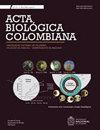巴西帕拉那州美国皮肤利什曼原虫流行区中间型Lutzomyia(Nyssomyia)的遗传多样性
IF 0.5
4区 生物学
Q4 PLANT SCIENCES
引用次数: 0
摘要
中间斑潜蝇(Diptera:Psychodidae)是参与美国皮肤利什曼病(ACL)在新热带地区传播的主要媒介之一。然而,涉及该分类单元的遗传学研究仍然处于起步阶段,对于理解不同种群的变异水平、它们的作用以及作为媒介的意义仍然很重要。本研究的目的是通过随机扩增多态性DNA(RAPD)来确定巴西巴拉那州ACL传播地区里贝拉河流域中间乳杆菌的遗传多样性水平。选择了两个城市来收集沙蝇:Cerro Azul(ACL的新传播区)和Adrianópolis(ACL的流行区)。这些昆虫是在房子里、橄榄岩里和野外(森林)捕获的。其中两个使用的标记可以估计研究群体的多态性,产生了40种基因型,其中大多数来自橄榄粒。用引物A10分析生成的树状图显示出不同程度的相似性,表明研究群体中可能存在基因流动。利用A2引物进行主坐标分析(PCO),可以根据中间乳杆菌的生态和地理来源对其进行分类。组成中间乳杆菌复合体的谱系之间没有区别。这项研究的结果,以及中间乳杆菌基因型多样性的记录,可能有助于解释巴西利什曼原虫(Kinetolastida:锥虫科)在该地区生命周期的维持。本文章由计算机程序翻译,如有差异,请以英文原文为准。
GENETIC DIVERSITY OF Lutzomyia (Nyssomyia) intermedia IN AN ENDEMIC AREA OF AMERICAN CUTANEOUS LEISHMANIASIS, STATE OF PARANÁ, BRAZIL
Lutzomyia intermedia (Diptera: Psychodidae) features as one of the main vectors that are involved in the transmission of American cutaneous leishmaniasis (ACL) in the Neotropical region. However, genetic studies involving this taxon are still incipient and important for understanding the level of variability of different populations, their role, and implications as vectors. The aim of this study was to determine the level of genetic diversity of L. intermedia present in the Ribeira River Valley, an area of ACL transmission in the state of Paraná, Brazil, through the Random amplified polymorphic DNA (RAPD). Two municipalities were chosen to collect sand flies: Cerro Azul (new transmission area of the ACL) and Adrianópolis (endemic area of the ACL). The insects were captured in the house, in the peridomicile and in the wild (forest). Two of the used markers made it possible to estimate the polymorphism of the studied populations, resulting in 40 genotypes, most of them from peridomicile. The dendrogram generated by the analysis with the primer A10 showed different degrees of similarity, suggesting that there may be gene flow in the studied populations. The Principal Coordinate Analysis (PCO) with the A2 primer, was useful in grouping L. intermedia according to its ecological and geographical origin. There was no distinction between the lineages composing the L. intermedia complex. The results of this study, with the record of great genotypic diversity in L. intermedia, may contribute to explain the maintenance of the life cycle of Leishmania braziliensis (Kinetoplastida: Trypanosomatidae) in the region.
求助全文
通过发布文献求助,成功后即可免费获取论文全文。
去求助
来源期刊

Acta Biologica Colombiana
Agricultural and Biological Sciences-General Agricultural and Biological Sciences
CiteScore
1.60
自引率
0.00%
发文量
21
审稿时长
13 weeks
期刊介绍:
The journal is published quarterly and divulges original and unpublished results of basic and applied research about biological subjects with special interest in Neotropical region. Manuscripts may be research articles, reviews, reflection articles or short notes. The Acta biol. Colomb Journal have a scientific and editorial board composed of expert researchers of in their areas of knowledge.
 求助内容:
求助内容: 应助结果提醒方式:
应助结果提醒方式:


